This is the fifth article in a year-long series that premiered in November 2021 on international standards for energy management. These standards support the transformation of the power grid from centralized generation to distributed energy resources including local solar, wind, and stored energy in homes and buildings.
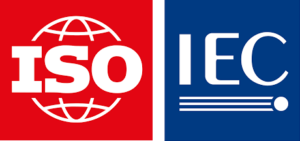 These are voluntary industrial standards developed to promote world trade by a committee I chair for ISO1 and IEC2. They are part of a family of standards for interconnected consumer electronics (home automation) called the “Home Electronic System” (HES) 3. I welcome your comments and participation in developing these standards; please visit kenwacks.com for contact data.
These are voluntary industrial standards developed to promote world trade by a committee I chair for ISO1 and IEC2. They are part of a family of standards for interconnected consumer electronics (home automation) called the “Home Electronic System” (HES) 3. I welcome your comments and participation in developing these standards; please visit kenwacks.com for contact data.
Appliances Designed for Energy Management
We buy appliances and consumer electronics for the services they provide such as convenience, entertainment, comfort, safety, and lighting. We are accustomed to having electricity available and affordable to operate all desired appliances anytime.
We face challenges as the 21st century grid is moving toward distributed energy resources (DER) using solar panels, wind turbines, and battery storage. Also, some states and provinces are mandating that power utilities implement time-of-use rates. As a result, power availability may fluctuate with the weather and time-of-day or may be relatively expensive at various times. How can we reap the benefits of appliances and consumer electronics with affordable electricity and minimal environmental impact? The solution is effective energy management. Energy management is a set of tools to help consumers allocate limited or expensive power cost-effectively to meet their needs and desires for appliance operation.
The second article in this series introduced and explained the key role of the international standard Energy Management Agent (EMA) to achieve a reasonable balance of these benefits and costs. This article explores how to integrate appliance operation in an energy management system organized around an EMA.
Responsive appliances
As I explained in the previous article in this series, the solution for effective remote control of appliances by an EMA is to design appliances for interruption or for operation in modes with various levels of reduced energy consumption. However, most appliances are not designed for such power interruption or control of operating modes via home network signals. Thus, the challenge for managing the energy consumption of such appliances is twofold: technology and marketing.
The optimal solution for managing appliance energy consumption is to design energy-reduction modes into appliances. The EMA might specify an energy reduction goal, such as 10%, in a message sent to each appliance. The appliance would react to this message according to the built-in capabilities. An appliance with energy mode control needs a communications capability such as an access port for remote control.
The technical elements for remote control include a connection to a communications medium, circuits to encode and decode the communication signals and embedded messages, plus a link to the appliance controller. ISO/IEC 10192-34 specifies interface standards for various communications media such as wires, power line carrier (data carried on electric power lines), and radio. Figure 1 illustrates a home with appliances containing network interfaces that are all interconnected via a home area network. The home area network connects appliances via the HES gateway to service providers according the functionality of the appliances.
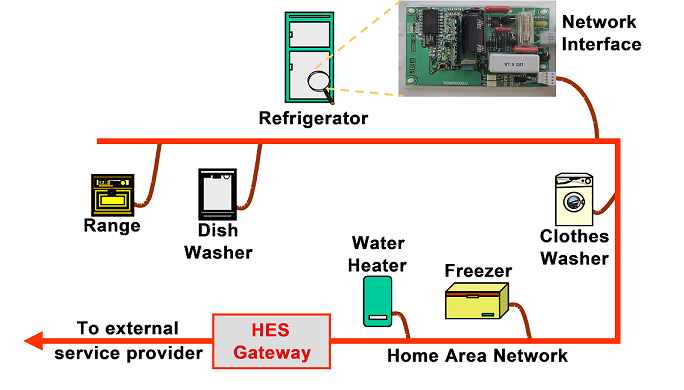
Figure 1 – Networked appliances
Modular Communications Interface (MCI)
ISO/IEC 10192-3 specifies a modular communications interface (MCI) for energy management signals and messages that could be exchanged between consumer devices and an EMA. These devices might include sensors, thermostats, and equipment that consumes or produces significant amounts power such as HVAC (heating, ventilation, and air conditioning), water heaters, kitchen appliances, pool pumps, electric vehicles, solar inverters, and battery storage.
The MCI standard is designed for managing equipment with long operating lives. For example many water heaters last about a decade while HVAC equipment may work for multiple decades with proper maintenance. In accounting terms, this is capital equipment (expensive products with a life longer than a year). Unlike consumer electronics (TVs, sound systems, smart phones, etc.), equipment targeted by the MCI standard is usually not replaced as technology evolves, nor is it changed in the field with an upgraded operating system or application software. This equipment usually does not include electronics with sophisticated interfaces or electronic controls such as high-speed processors and lots of memory. If a change in communications is required, it should be a plug-on module that is installable by the consumer.
The MCI standard specifies a simple serial interface between a removable communications module and the equipment whose energy consumption is to be managed. The serial interface in the equipment is permanently installed and terminated with one of two types of modules and associated connectors: one powered by AC, the other by DC. The removable communications module plugs into either the AC or DC interface. The communications module can be designed for various home network media and protocols such as wired Ethernet or wireless Wi-Fi, Z-Wave, Zigbee, etc. With this arrangement the communications module might be swapped for a newer module as home networks are upgraded, while the capital equipment is unchanged.
MCI technology
The MCI specifies a plug-in communications module that can be designed for a specific wired or wireless communications protocol plus a wired connection into a residential device using a serial link. This module is called a Universal Communication Module (UCM), while the device to which it attaches is called the Smart Grid Device (SGD). Communication links may be provided for a wired network, power line carrier (PLC), or radio frequency (RF), depending on the home area network installed. The MCI plug-in module may be user-installable into a consumer product marketed as smart-grid ready. Figure 2 illustrates a thermostat (SGD) that accommodates two plug-in MCI modules (UCMs): one for Wi-Fi and one for Zigbee. Below the thermostat in this figure are additional UCMs that could replace the Wi-Fi or Zigbee module to support other home network protocols. Provision for an MCI in a water heater is shown in Figure 3. The water heater includes a permanently installed MCI connector into which a UCM is plugged.
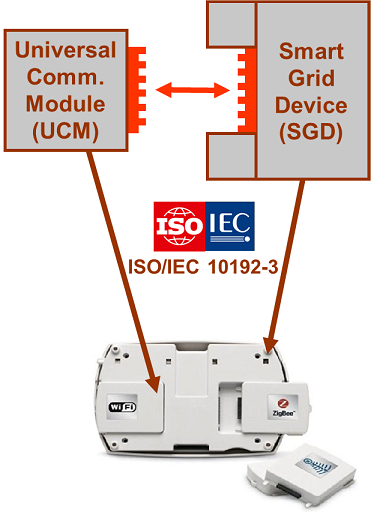
Figure 2 – MCI options for a thermostat
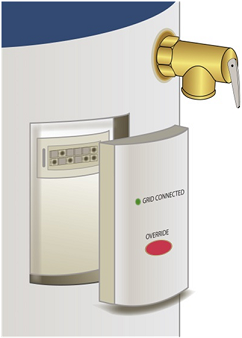
Figure 3 – MCI module for a water heater
Two physical form factors are specified for the UCM and the connectors between the UCM and SGD. Both are powered from a DC or AC supply in the SGD. For both form factors the communication messages across the socket interface are the same.
– DC UCM
The DC option uses a low-voltage supply (3 VDC or 5 VDC and –0.3 VDC) from the SGD and a serial peripheral interface (SPI)5. This option might be attractive in cases where the SGD has no AC power source or when a small socket size is required (about 2 inches by 2 inches). The DC connector module is about 2-inches long and contains the interface pins diagrammed in Figure 4
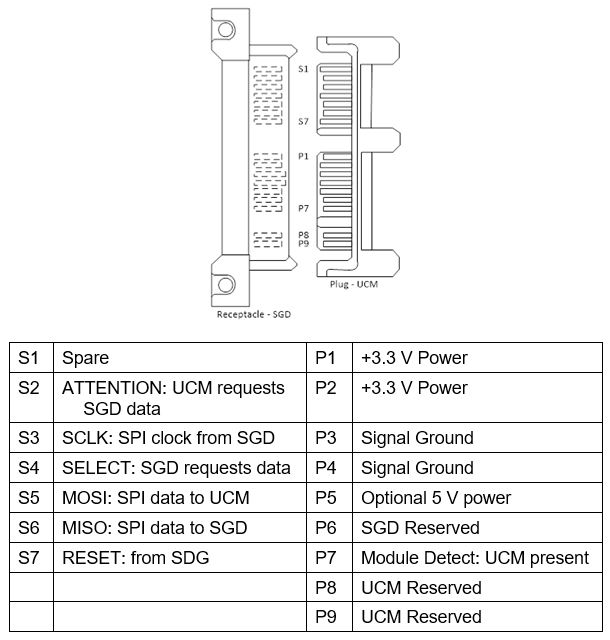
Figure 4 – MCI AC connector and pin functions
– AC UCM
The second form factor provides AC service (120/240 V) from the SGD and an RS-485 serial interface6, as shown in Figure 5. This option might apply where the SGD does not provide a DC power supply, where power line carrier (PLC) communications is desired, or where the UCM needs access to line frequency. Figure 3 illustrates the AC connector installed in the body of the water heater.
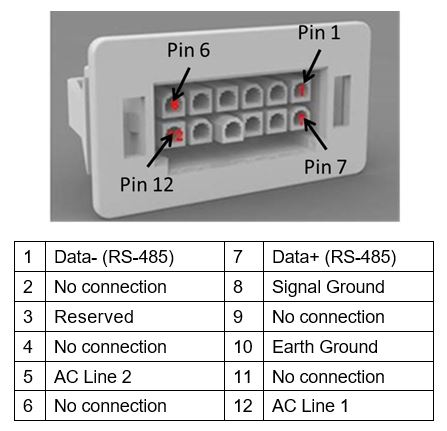
Figure 5 – MCI DC connector for SDG and pin functions
MCI applications messages
The MCI standard specifies the communications protocol between the UCM and the SGD via the serial interface including messages for demand-response (DR) energy management and messages for managing the serial link. The energy management messages are categorized as basic (required) and intermediate (optional). The basic commands include
- SGD load shed (requesting the SGD not to draw power)
- Power consumption limits
- Relative price level for power
- Critical peak event
- Grid emergency
- Grid guidance (indication of whether energy consumption is preferred or not)
- Customer override (sent by the SGD)
- Load up (e.g., for a water heater to pre-heat up to the temperature set-point when power price is lower)
- Pending event time and type (for a DR event)
The intermediate commands for those SGDs with enhanced capabilities include exchanges regarding:
- SGD efficiency level
- Energy price (tariff, current and future price, selling price for transactive energy)
- Operating tier
- Temperature (current, set-point, offset)
- Autonomous cycling
- DR schedule
- Advanced load up (pre-heat beyond the temperature set-point7)
The MCI standard also allows the serial link between the UCM and SGD to carry a variety of other communication protocols for network, transport, and application layer messages (called the “pass-through” mode) including:
- ISO/IEC 14543-3 series of international standards (KNX)
- ISO/IEC 14543-4 series of international standards (Echonet)
- ISO/IEC 14908 series of international standards (LonTalk)
- ISO 16484-5:2014, also specified as ANSI/ASHRAE 135-2020 (BACnet®)
- IEC PAS 62746-10-1:2014 (OpenADR 2.0)
- IEEE 2030.5 (Smart Energy Profile (SEP))
- Generic IP (Internet Protocol)
- ClimateTalk (a protocol from an HVAC trade association
- SunSpec (a protocol from a solar power trade association)
- USNAP (a protocol from a trade association for MCI proponents)
The choice of message set depends on the program offered by the energy and equipment suppliers. Message sets may be added to accommodate future protocols. This standard affords manufacturers, consumers, and service providers flexibility to select the best solution for the local environment.
MCI extensions
An update of ISO/IEC 10192-3 is being considered to accommodate smaller interface form-factors and device profiles including message sets for:
- Thermostats
- Lighting control
- Distributed energy and storage resources
- Solar inverters
- Energy management controllers and agents
- User interface devices
- Stationary and portable appliances
- Sensors and actuators
MCI history and certification
The specifications for the MCI standard originated in the first decade of the 21st century as two independent specifications from the Electric Power Research Institute (EPRI, an energy research organization) and the U-SNAP Alliance (a trade association). Both were proposed to the Home-to-Grid committee, a working group created by the National Institute of Standards and Technology (NIST), part of the US Department of Commerce, and the GridWise® Architecture Council (GWAC), created by the US Department of Energy). As chair of this committee I was seeking communication tools to facilitate appliance energy management.
The tool needed was an interface for appliances to communicate via a home network with a local energy management controller such as the EMA or with an external aggregator or utility. Despite the publication in the 1990s of a unified communications protocol for home networks including multiple media options8, the industry fragmented and issued dozens of protocols, often conflicting. Since the industry has not and is not likely to adopt one communications protocol for home networks, EPRI and the U-SNAP Alliance sought a universal plug-in adapter so appliances communicated one set of energy management messages via the particular communications protocol chosen for the home network.
EPRI and the U-SNAP Alliance responded to my request for information. Since the two specifications were similar, I encouraged both organizations to investigate a common specification. They did and produced the first version of MCI, which was reviewed, edited, and published by the Home-to-Grid committee. With the approval of NIST and GWAC, I offered this specification to the Consumer Technology Association (CTA). CTA is a trade association of consumer electronics companies. CTA hosts the Consumer Electronics Show each January in Las Vegas, usually the largest trade show in the US. The American National Standards Institute (ANSI) accredited CTA to develop American National Standards for consumer electronics. CTA established the R7.8 standards committee, which I chair, to develop the MCI family of standards.
The MCI standards specify requirements to which manufacturers must comply in order to advertise that their products conform with MCI. Most standards depend of self-certification for claiming conformance. A trade association called the OpenADR Alliance has developed test procedures and a voluntary certification program for manufacturers. OpenADR established the brand name EcoPort, as explained on https://www.openadr.org/ecoport-supplemental:
EcoPort is the brand name for technology that has been certified compliant with the CTA 2045 technical specification. Compliance means that a product has been submitted to the EcoPort certification program (operated by the OpenADR Alliance …).

MCI adoption
ISO/IEC 10192-3 provides consumer electronics companies and appliance manufacturers flexibility to adapt products for smart grids by reducing the risks and costs of using proprietary communication technologies. Manufacturers can focus on competitive product features and applications while incorporating standard interfaces. This approach expedites product design and encourages product innovation, while facilitating energy management and conservation features in a wide range of consumer products.
MCI interfaces have been installed in water heaters, electric vehicle (EV) chargers, air conditioners, and swimming-pool pumps. Some governments are mandating the incorporation of MCI into these products. The US states of Oregon and Washington require MCI interfaces for all new water heater installations. California has mandated MCI9 for new construction and large retrofits. The California Energy Commission is considering joining Oregon and Washington in the next three-year code-revision cycle of the California Building Energy Efficiency Standards (Title 24). According to the OpenADR Alliance, “Several states in New England are considering similar mandates. EcoPort/CTA-2045 also is being discussed as a possible requirement for Federal purchasing of appliances.” The latest ENERGY STAR10 specification for energy-efficient connected water heaters references the MCI standard as an option.
1. ISO is the International Organization for Standardization, founded in 1947, www.iso.org.
2. IEC is the International Electrotechnical Commission, founded in 1906, www.iec.ch.
Both ISO and IEC are headquartered in Geneva, Switzerland.
3. The Home Electronic System (HES) is the name of the international standards committee officially designated as ISO/IEC JTC 1/SC 25/WG 1:
JTC 1 = Joint Technical Committee 1, entitled Information Technology
SC 25 = Subcommittee 25, entitled Interconnection of Information Technology Equipment
WG 1 = Working Group 1, entitled Home Electronic System
4. ISO/IEC 10192-3, Information Technology – Home Electronic System (HES) interfaces – Part 3: Modular Communication Interface (MCI) for energy management
5. According to Wikipedia (https://en.wikipedia.org/wiki/Serial_Peripheral_Interface), SPI
is a four-wire synchronous serial bus used for short-distance communication, primarily in embedded systems. The interface was developed by Motorola in the mid-1980s and has become a de facto standard
6. RS-485 (officially called ANSI/TIA/EIA-485-A) is an America National Standard for serial communications using a balanced cable such as ungrounded twisted-pair wires.
7. A water heater that pre-heats water above the temperature set by the user requires a water mixing system to lower the temperature to the set-point before delivery through the plumbing network to avoid scalding the occupants.
8. ANSI/CEA-600, the CEBus series of 28 standards published in the 1990s.
9. Title 24, Joint Appendix 13 of the California Energy Commission Building Energy Efficiency Standards.
10.ENERGY STAR, part of the US Department of Energy, offers product-label information about energy-efficiency.
© Copyright 2021 Kenneth P. Wacks
Dr. Kenneth Wacks has been a pioneer in establishing the home systems industry. He delivers clear and practical advice to manufacturers and utilities worldwide on business opportunities, network alternatives, and product developments in IoT and AI for home and building systems. The United States Department of Energy appointed him to the GridWise® Architecture Council to guide the electric industry toward smart grids. For further information, please contact Ken at +1 781 662-6211; [email protected]; www.kenwacks.com.


